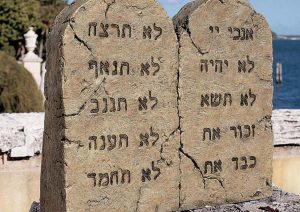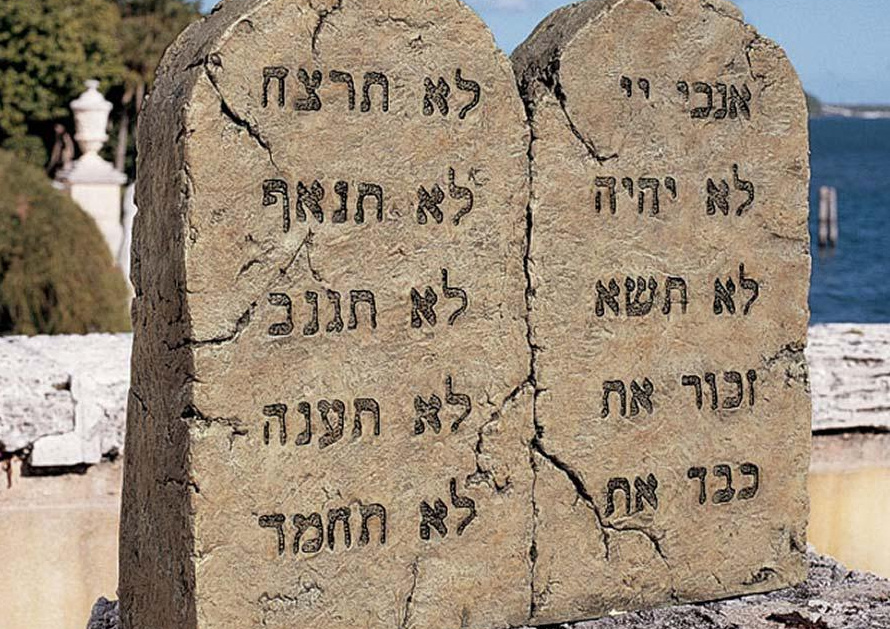
The Aseros HaDibros, Ten Commandments heard at Sinai (Shemos 20:2-17, Devarim 5:6-21) were inscribed on Two Tablets of Stone and brought down by Moshe from G-d to the people. They are equally divided into mitzvos bein adam l’mokom, laws between man and G-d and mitzvos bein adam l’chaveiro, interpersonal laws. The Ten Commandments are the most famously recognized of all the mitzvos.
What distinguishes the Ten Commandments from all the other 613 laws in the Torah, which were also accepted at Sinai, is that the Ten Commandments act as the “categories” under which all the other commandments are included (Rashi, Shemos 24:12).
Several rabbinic works group the mitzvos according to their association with the Ten Commandments highlighting them as t he ideological basis for the 613 mitzvos in the Torah. This is beautifully alluded in how the text of the Ten Commandments contains 620 letters (Bamidbar Rabbah 13:16) that correspond to the 613 mitzvos plus the 7 rabbinic precepts (or the 7 Noachide laws). Of parenthetic note, is how the number 613 itself reduces to (6+1+3=) 10.
The Ten Commandments is the national, communal bond forever linking the destiny of Israel to the Torah. In-other-words, it is a deep symbol of the eternal covenant struck between G-d and His chosen nation. This is understood because the Ten Commandments was the text engraved upon the Shtei Luchos HaAvonim, Two Tablets of Stone. It would be these Luchos, that would forever reside at the center of Jewish life and within their hearts.
The phrase “koseiv al luach libecha”, meaning “You should inscribe these words upon the Tablets of your heart” can be applied to the inscription of the Ten Commandments upon the Tablets. Just as the letters of the Tablets were engraved into the stone, so too, should the laws of Torah be engraved upon our hearts. Always.
The Ten Commandments powerfully evokes the significance of the number “10”.
Perhaps the two, most prominent other usages of the number “10” are the Asarah Maamaros, Ten Utterances through which G-d created the universe and the Aseros HaDibros, Ten Plagues of the Exodus declaring Him the Supervisor of His creation.
Symbolically, 10 is the number where individual units are united in a collective whole. The human hands and feet were created with a total of 10 digits. 10 is also where individual personalities enter the categorization of a community, or a congregation into which the Shechinah, Divine Presence rests and the symbol of holiness. It is the presence of 10 men that makes a Minyan, “quorum”. The symbol of kedusha, “sanctity” is repeatedly associated with the number 10: the recitation of Kaddish in prayer and that of Kedusha, in repetition of the Amidah warrants a minimum of 10 people. And the dimensions of the Holy of Holies, where the Ten Commandments were held, were 10 cubits long, 10 cubits wide and 10 cubits deep (Rashi, Shemos 26:31)
So “10” represents the completed “holy” vision of existence.
The unifying picture began in the creation of the world, via the plagues with which Israel would emerge from Egypt, to their arrival at Sinai. Together, the “creation” (Ten Utterances) and “Exodus” (Ten Plagues) were the prelude to Sinai and the acceptance of Torah and mitzvos (Ten Commandments). The reason is that Torah, itself the blueprint of creation, was the affirmation of a world created by G-d in which the Children of Israel, once redeemed from Pharaoh, exist to become the holy people to observe and learn His laws.
Thus, the Ten Commandments go to the heart and soul of the 613 mitzvos.
Their stature – as indicative of all the commandments – emphasize the elevated stature of the Jewish people gained at Sinai with their coveted title of goy kodosh, “holy nation”. It would be from henceforth onwards that the completed version of creation would be played out – so long as the Children of Israel hang on to their eternal bond and always sanctify themselves in the performance of the will of G-d. The course material is presented by Osher Chaim Levene, author of “Set in Stone: The Meaning of Mitzvah Observance” (Targum/Feldheim), a writer and educator in London.


